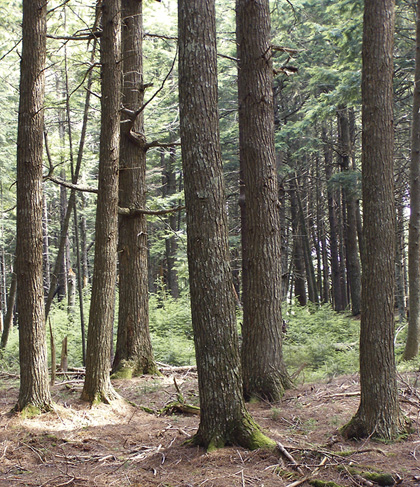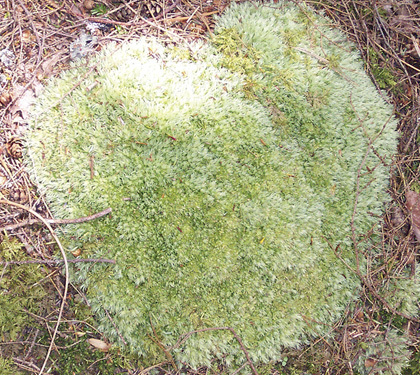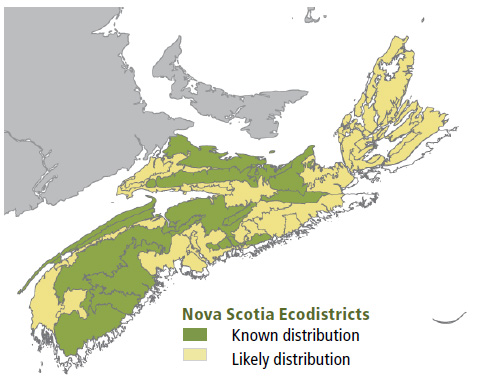
Forest Vegetation types - SH1
SH1 — Hemlock / Pin cushion moss / Needle carpet
Tsuga canadensis / Leucobryum glaucum
 |
Alma, Pictou County |
Concept: This late successional Vegetation Type (VT) has an overstory dominated by hemlock, with only scattered red spruce, white pine and/or yellow birch. Hemlock dominance persists because of its ability to shade out other trees once it becomes established in the canopy. Due to the long-lived and shade-tolerant nature of hemlock, this VT will develop old forest characteristics that are maintained by gap disturbances. However, infrequent hurricanes and/or fires may periodically renew this VT at a stand-level. SH1 is a typical Acadian softwood VT found on zonal sites throughout mainland Nova Scotia and parts of Cape Breton.
Vegetation: Hemlock is the dominant overstory tree. The shrub layer is primarily regenerating conifers, especially hemlock, red spruce and balsam fir. Herb cover can be diverse, but coverage is usually low. Typical species include evergreen wood fern, rose twisted stalk and starflower. The forest floor is mostly needle carpet with low bryophyte coverage. Pin cushion moss is often found in this VT, and occurrence of bazzania can be significant where coarse woody debris (CWD) has accumulated on the forest floor.
Environmental Setting: SH1 is mainly associated with dry to fresh/moist, nutrient medium soils of glacial or glaciofluvial origin. This VT can be found throughout mainland Nova Scotia and parts of Cape Breton. In Cape Breton it is only found on steep slopes of major rivers and along the Bras d'Or Lakes. On the mainland, SH1 is most often found within the Western ecoregion due to hemlock's preference for warmer climatic conditions. Across the Acadian Forest region, most occurrences of this VT are in Nova Scotia.
Successional Dynamics: SH1 is a late successional climatic climax VT dominated by hemlock. It can develop from several early and mid-successional VTs including IH3 (Large-tooth aspen / Christmas fern – New York fern), IH4 (Trembling aspen / Wild raisin / Bunchberry), IH6 (White birch – Red maple / Sarsaparilla – Bracken), SH5 (Red spruce – Balsam fir / Schreber's moss), SH6 (Red spruce – Balsam fir / Stair-step moss – Sphagnum) and SH8 (Balsam fir / Wood fern / Schreber's moss). SH1 can also transition from the climax unit SH3 (Red spruce – Hemlock / Wild lily-of-the-valley) depending on disturbance patterns. Early successional stages can be by-passed if at the time of disturbance advanced hemlock regeneration is retained (as could happen after a stand-level disturbance such as windthrow or harvesting). Depending on disturbance history, this VT can be even-aged, but it will develop an uneven-aged structure as it matures. Between large-scale disturbance events SH1 will be maintained through gap replacement.
Ecological Features: Stands typically form large patches in the Western ecoregion and small patches elsewhere. Hemlock is the province's longest-lived softwood species promoting old growth development. The oldest forests support lichens, such as coral lichen, indicators of ecological continuity. This tree is also very shade-tolerant, responding well to release after decades of understory suppression. Mature stands provide large diameter cavity trees and very decay-resistant snags and coarse woody material. This forest may provide cover for moose and deer, and habitat for marten, flying squirrels and diverse fungi. Downed coarse woody debris may provide cover for red-backed salamanders and small mammals, while large trees can provide pileated woodpecker, barred owl and northern goshawk nest sites. Boreal chickadee, pine siskin, and both white-winged and red crossbills eat hemlock seeds. Downy and creeping rattlesnake plantains are the only known rare plants.
 |
| Pin cushion moss |
Distinguishing Features: This is a softwood forest dominated by hemlock on well drained sites. Shrub and herb layers are very sparse. The forest floor is typically needle carpet with low moss coverage. Pin cushion moss is common.
| Slope Position: | Middle3 Level2 Lower2 Upper2 Other1 |
Surface Stoniness: |
(Non - Slightly)5 (Moderately)3 (Very - Excessively)2 |
Bedrock Outcrop: |
(Non-rocky)10 |
Elevation Range: |
12 - 200m |
Slope Gradient: |
Gentle4 Level2 Moderate2 Other1 nd1 |
Aspect: |
North1 East2 South3 West2 None2 |
Exposure: |
Moderate6 Mod. exposed2 Mod. sheltered2 |
Microtopography: |
Moderately3 Slightly3 Strongly2 Other2 |
Drainage: |
Well5 Moderately well4 Imperfect1 |
Soil Type: |
ST25 ST2-G1 ST2-L1 ST61 ST81 Other1 |
Parent Material: |
Glacial till7 Glaciofluvial1 Other1 nd1 |
Rooting Depth (cm): |
(<30)1 (30-45)4 (>45)4 nd1 |
Duff Thickness (cm): |
(0-5)2 (6-10)4 (11-20)2 nd2 |

